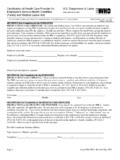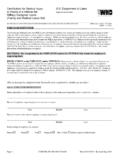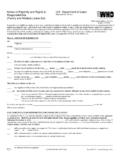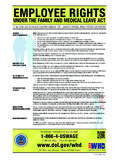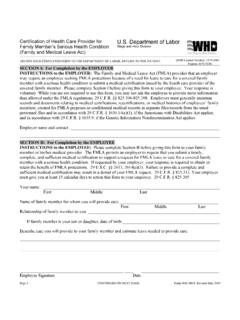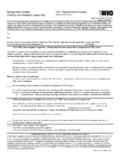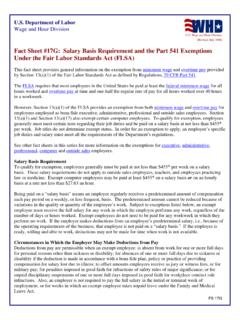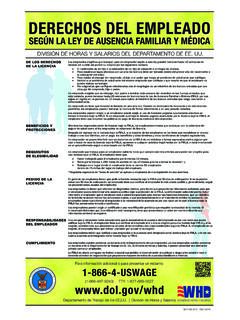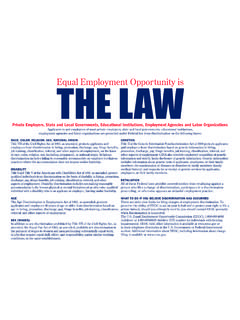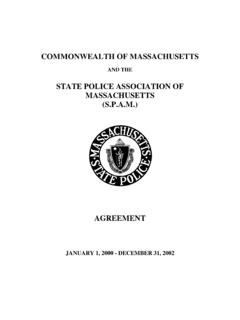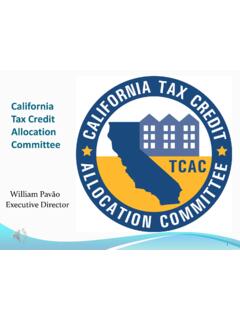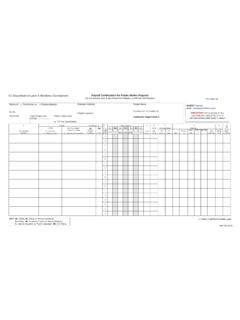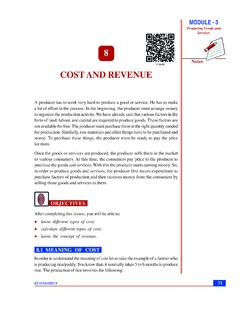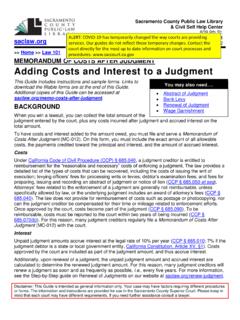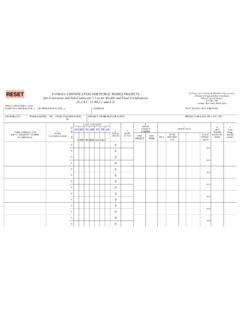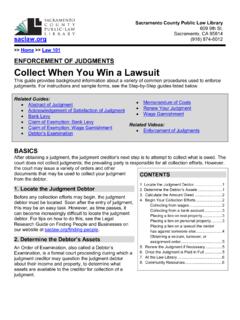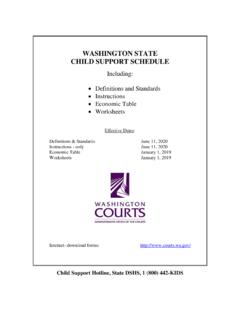Transcription of Overtime Pay on DBA/DBRA Contracts
1 DEPARTMENT OF LABOR Overtime PAY ON prevailing wage RESOURCE BOOK DBA/DBRA Contracts Overtime PAY ON DBA/DBRA Contracts DEPARTMENT OF LABOR Overtime PAY ON prevailing wage RESOURCE BOOK DBA/DBRA Contracts APPLICATION OF CWHSSA EXAMPLES OF Overtime PAY COMPUTATIONS ON DBA/DBRA Contracts WITH CWHSSA APPLICATION OF FLSA Overtime PAY REQUIREMENTS TO WORKERS EMPLOYED ON DBA/DBRA Contracts STATE AND LOCAL wage AND HOUR LAWS DEPARTMENT OF LABOR Overtime PAY ON prevailing wage RESOURCE BOOK DBA/DBRA Contracts 1 CWHSSA/ Overtime PAY ON DBA/DBRA Contracts Application of CWHSSA CWHSSA applies to laborers, mechanics, guards and watchmen for the time spent on covered contract work only. Total up all time each employee spent working on covered Contracts off-site as well as on-site on DBA/DBRA projects; Exclude all work not performed under DBA/DBRA and/or SCA Contracts .
2 CWHSSA requires the payment of time and one-half the basic rate of pay for all hours worked in excess of 40 hours in a week. (The daily Overtime requirement under CWHSSA was repealed in 1986.) The basic rate of pay under CWHSSA is the straight time hourly rate generally the amount listed in the RATE column, apart from the fringe benefit amount (if any) listed for a classification in the wage determination. The basic rate cannot be less than the basic hourly rate required in an applicable wage determination. See 29 Under DBA/DBRA , amounts paid to fulfill the fringe benefit portion of the prevailing wages listed in the wage determination including both contractor contributions to bona fide benefit plans and cash payments made to comply with the fringe benefit portion of the prevailing wage requirement are excluded in computing Overtime obligations under CWHSSA. CWHSSA does not have a site of the work limitation on coverage.
3 All hours worked on covered Contracts (even at a fabrication shop away from the site) are combined for determining CWHSSA compliance. (For example: if an employee starts the day performing covered work at the fabrication shop and then travels to the work site, the time at the fabrication shop and the travel time between the fabrication shop and the work site is hours worked covered by CWHSSA.) If in a single workweek an employee works in more than one classification for which different non- Overtime rates of pay have been established, the Overtime pay may be computed based on the weekly average rate (or regular rate ) the total straight time pay for work (at all such rates) during the week, divided by the DEPARTMENT OF LABOR Overtime PAY ON prevailing wage RESOURCE BOOK DBA/DBRA Contracts 2 total number of hours worked at all jobs worked in the workweek. (An employee who performs work in two or more classifications for which different straight time hourly rates are established may agree with his/her employer in advance of performing the work, to be paid during Overtime hours at a rate not less than one and one-half times the hourly non- Overtime rate established for the type of work he/she is performing during such Overtime hours.)
4 29 , , and CWHSSA (as well as FLSA) requirements apply only to hours worked. Non-work hours such as paid holidays and paid leave are not counted in computing Overtime pay. Rules concerning Hours Worked are at 29 CFR 785. Examples of Overtime pay computations on DBA/DBRA Contracts with CWHSSA The following examples reflect the correct computations under DBRA and CWHSSA for an employee who worked 44 hours on a covered contract as an electrician, where the wage determination rate for an electrician is $ (basic hourly rate) plus $ in fringe benefits ( prevailing rate is $ + $ = $ ). If the employer paid $ in cash wages and paid $ for fringe benefits, the electrician would receive: 44 hours x $ = $ for cash wages 44 hours x $ = $ in fringe benefits 4 hours x x $ = $ for CWHSSA earnings $ If the employer paid $ in cash wages and $ cash in lieu of fringe benefits: 44 hours x $ = $ in cash wages 44 hours x $ = $ in fringe benefits 4 hours x x $ = $ in CWHSSA earnings $ DEPARTMENT OF LABOR Overtime PAY ON prevailing wage RESOURCE BOOK DBA/DBRA Contracts 3 If the employer paid $ in cash wages and $ in fringe benefits per hour: 44 hours x $ = $ in cash wages 44 hours x $ $ cash in lieu of fringe benefits 44 hours x $ = $ in fringe benefits 4 hours x x $ = $ in CWHSSA earnings $ Note.
5 In some cases a question arises over whether a cash payment made to a laborer or mechanic is paid instead of a fringe benefit contribution or whether it is simply part of the individual s normal basic hourly rate. In the latter situation, the cash payment is not excludable in computing the Overtime pay obligation. Thus, in the third example above if the employer normally or previously was paying the individual $ an hour with no fringe benefits on other projects (not subject to the prevailing wage requirements), the employer would not get credit for $ cash in lieu of fringe benefits. Instead, the worker s regular or basic rate would be $ per hour and the correct Overtime pay rate would be one and one-half times $ ( $ + $ = $ per hour for hours worked over 40 in a week. 29 ( c )(1) through (3). The following examples provide two methods for the computation of Overtime premium pay required under CWHSSA and/or FLSA for an employee who worked in different job classifications and at different rates of pay in the same work week.)
6 An employee is hired to perform work on a covered construction contract in two job classifications: painter and electrician. The wage determination rate for an electrician is $ (basic hourly rate) plus $ in fringe benefits. The wage determination rate for a painter is $ (basic hourly rate) plus $ in fringe benefits. The payroll shows that the worker performed painting and electrical duties as follows: S M T W T F S Painter hours 10 10 10 Electrician hours 10 8 DEPARTMENT OF LABOR Overtime PAY ON prevailing wage RESOURCE BOOK DBA/DBRA Contracts 4 Method 1: Computation of the Overtime premium based on the weekly average regular rate for the work week. Step 1: Determine the straight time wages due excluding fringe benefits 30 hours at the painter s rate of $ = $ 18 hours at the electrician s rate of $ = Total straight time wages = $ Step 2: Calculate the regular rate ($ / 48 hours worked) = $ regular rate Step 3: Compute the Overtime premium due ($ ) x 8 Overtime hours worked = $ Note: It is important to note that if a worker s regular rate of pay exceeds the basic hourly rate listed in the applicable Davis-Bacon wage determination, then the employee s regular rate of pay must be used in computing the Overtime pay premium for FLSA purposes.
7 See 29 Method 2: Computation of the Overtime premium based on the rate in effect when the Overtime hours were worked. In this example the eight Overtime hours occurred on a Saturday. The Overtime premium could be computed as follows: ($ ) x 8 = $48 Application of FLSA Overtime pay requirements to workers employed on DBA/ DBRA Contracts On Contracts to which CWHSSA does not apply (for example, on a prime contract $100,000 or less) Overtime pay requirements may apply to a contractor or subcontractor under other laws, including the FLSA. On Contracts to which CWHSSA applies, FLSA may also apply. As a general standard, Section 7(a) of the FLSA, as amended, provides that an employer shall not employ any employee to work in excess of 40 hours in a DEPARTMENT OF LABOR Overtime PAY ON prevailing wage RESOURCE BOOK DBA/DBRA Contracts 5 workweek unless such employee receives compensation for his or her employment in excess of the hours above specified at a rate not less than one and one-half times the regular rate at which he or she is employed.
8 29 Unless specifically exempted from FLSA Overtime pay requirements, an employee who performs work on both federally funded/federally assisted projects and commercial work in the same workweek must receive an Overtime premium for hours worked in excess of 40 in the workweek. 29 778. (Note: 29 and discuss dual application of Davis-Bacon and FLSA Overtime requirements.) State and Local wage and Hour Laws In some instances, State and local wage and hour laws apply similar or additional wage and Overtime pay requirements and can apply concurrently. Where questions arise regarding wage and Overtime pay requirements under State (or local) law on DBA/DBRA projects, the appropriate State (or local) government agency should be consulted regarding compliance with the non-federal requirements.
